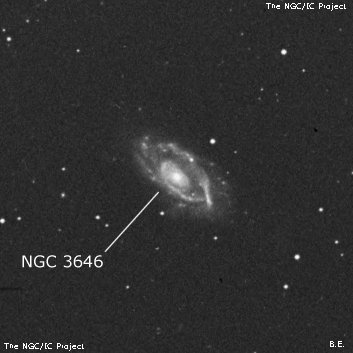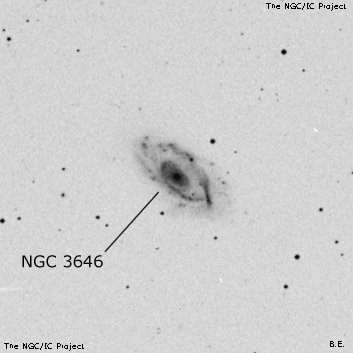NGC/IC Project Restoration Effort
(This is a very very beta version)
NGC3646


Basic Information
Location and Magnitude
Right Ascension: 11:21:43.2
Declination: +20:10:9
Constellation: LEO
Visual Magnitude: 11.1
Historic Information
Discoverer: Herschel W.
Year of discovery: 1784
Discovery aperture: 18.7
Observational
Summary description: cF, cL, lE, gbM, sp of 2
Sub-type: Sbc/P
Corwin's Notes
=====
NGC 3646. See IC 682 = NGC 3649 where I suggest that Swift's note of a "very
faint star close north preceding" actually applies to his observation of this
galaxy. He somehow confused it with his observation of the fainter galaxy.
Curiously, WH puts this object, as well as NGC 3649 which he observed in the
same sweep, into his third ("very faint nebulae") class of objects. This is
fully three magnitudes brighter than N3649. The only reason I can see is that
the surface brightness is lower. JH has them right, though the final
"brightness" in GC and NGC ("cF") is an unsatisfactory compromise.
Steve's Notes
=====
NGC 3646
48" (5/16/12 and 4/6/13): this showpiece spiral appeared bright, large, oval ~2:1 SW-NE, sharply concentrated with a very bright core. The visual treat was a prominent lens or eye-shaped ring surrounding the core! The ring was slightly brighter in an arc along the north side. At the west edge of this arc was a very faint quasi-stellar knot (SDSS J112141.34+201039.0, V = 17.2). Another section of the ring that stands out is along the southwest edge, with a brighter linear piece about 40" long that has several SDSS designations. The interior of the ring is fairly dark near this section, as well as other sections, providing a good contrast with the core and ring. A very small, weak brightening was also noted on the northeast end of the ring. A mag 14 star lies 1.4' NW of center and a mag 16 star is 1' SSE of center.
17.5" (4/14/01): moderately bright, fairly large, elongated 3'x2' SW-NE. Gradually increases to a brighter 30" oval core. A quasi-stellar nucleus is occasionally visible with direct vision. Forms a pair with NGC 3649 7.8' ENE.
13.1": moderately bright and large, elongated, broad concentration with no nucleus. An extremely faint star or knot is involved.



